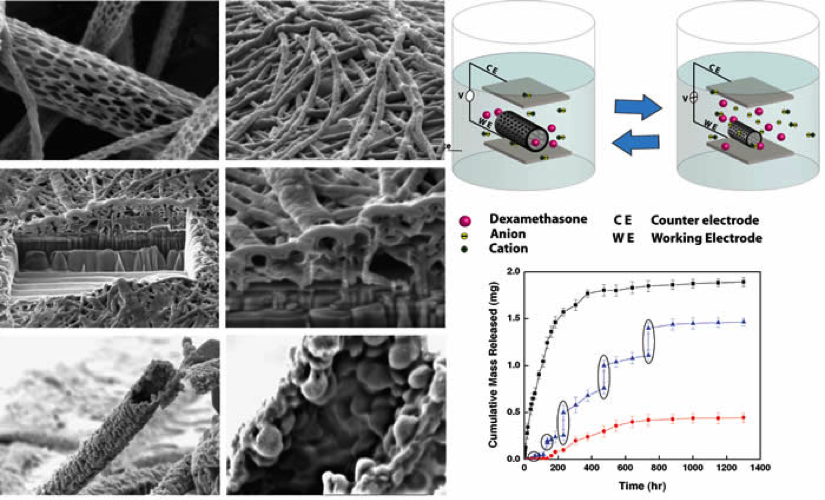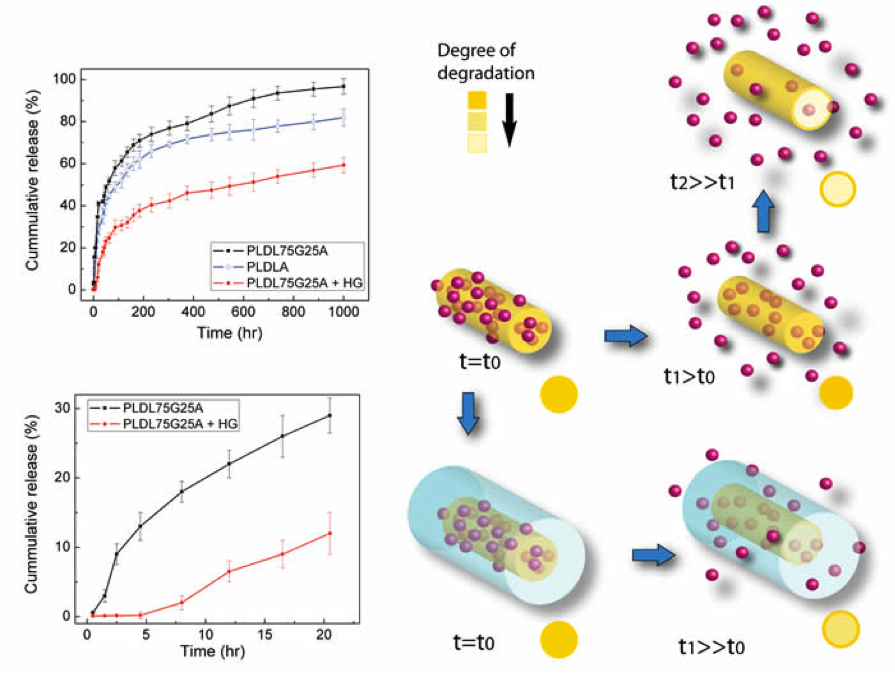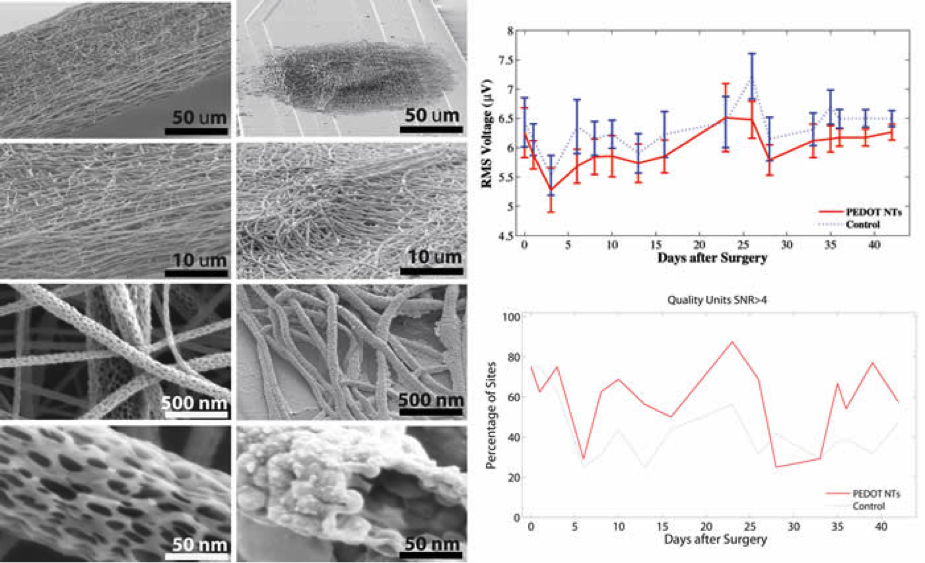
RESEARCH
Abidian research group works at the interface of biomaterials and electronic devices to develop next-generation neural interfaces. Engineering these systems requires an interdisciplinary approach that incorporates aspects of polymer synthesis, micro/nano-fabrication techniques, and cell-biomaterials interactions. These electronically active devices have a broad range of applications such as controlled drug delivery, neural recording, and stimulation, neurochemical sensing, and axonal regeneration.
Current efforts are focused on the following areas:
- Multifunctional organic-inorganic hybrid nanobiomaterials for smart targeted drug delivery to brain tumors.
- Bioactive conducting polymer and carbon nanotubes for axonal regeneration and biotic-abiotic interface of neural prostheses.
- Chronic, selective, and sensitive detection of neurochemicals using conducting polymer micro/nano-tubes.
Nanostructured Conducting Polymers for Improvement of Electrical Properties of Neural Microelectrodes:
A low impedance electrode-tissue interface is important to maintain signal quality for recording and effective charge injection density for stimulation. Neural microelectrodes, however, suffer from high electrode impedance due to small feature geometry. Organic conducting polymers such as poly(pyrrole) (PPy) and poly(3,4-ethylenedioxythiophene)(PEDOT) have electrical properties similar to semiconductors and metals while their mechanical properties are similar to conventional polymers. These materials have been considered for biomedical applications such as neural interfaces because of their physical, electrical, and biocompatibility characteristics. To improve the impedance of neural electrodes, I developed novel methods for fabrication of conducting polymer nanotubes and nanostructured cloud-like conducting polymer within alginate scaffolds on the surface of neural electrodes. Results demonstrated that the electrical properties of neural microelectrodes were significantly improved by decreasing impedance from an average of 783 kΩ to 2.5 kΩ and increasing charge transfer density from an average of 1.3 mC/cm2 to 223.8 mC/cm2. These results indicated that nanostructured PEDOT can serve as a biocompatible coating for significant improvement of the electrical properties of neural interfaces.

M. R. Abidian, D. C. Martin, Adv. Funct. Mater. 2009, 19, 573. DOI: 10.1002/adfm.200801473
Conducting Polymer Nanotubes for On-Demand and Precisely Controlled Drug Relesae:
Studies have shown that the response of brain tissue to implanted microelectrodes includes an acute injury and a chronic reactive tissue response. The chronic response is characterized by the presence of both activated microglia and reactive astrocytes, which eventually encapsulate the electrode to some degree6. Although studies have shown that systemic delivery of anti-inflammatory drugs such as dexamethasone to the site of implantation can moderately mitigate the encapsulation process. There are serious therapeutic side effects due to the requisite high systemic levels of these drugs. Organic conducting polymers can actuate during oxidation and reduction through volume changes from ion and/or solvent mass transport8. I designed and developed a unique method for fabrication of drug-loaded conducting polymer nanotubes using drug-incorporated biodegradable nanofiber templates. Results indicated that PEDOT nanotubes could be used as drug reservoirs and dexamethasone could be locally released either by passive delivery resulting from controlled degradation of core nanofibers or by actively pumping the conducting polymer nanotubes with an electrical stimulation. These are highly significant results that establish a novel method for on-demand and precisely controlled drug delivery to the nervous system using an applied voltage as small as 1 V vs. reference electrode.

M. R. Abidian, D. H. Kim, D. C. Martin, Adv. Mater. 2006, 18, 405. DOI: 10.1002/adma.200501726
Electrospun Nanofibers and a Naturally Based Hydrogel Hybrid System as Controlled Drug Delivery System:
The mechanical properties of soft brain tissue (~10 kPa) and hard silicon-based neural microelectrodes (~200 GPa) differ greatly. Studies have shown that cellular reactive responses and fibrous tissue encapsulation are correlated with insertion and device micromotion trauma due to this mismatch of mechanical properties. I applied a hybrid system, including drug loaded biodegradable nanofibers and alginate hydrogel coatings to the surface of microelectrodes. Alginate coating can provide a mechanical buffer layer to mediate the mechanical mismatch and a diffusion barrier to control drug release. The results showed a drug burst effect due to the fast hydrolytic degradation of biodegradable nanofibers; however, adding an alginate hydrogel layer controlled the burst effect and the rate of drug release. These results are significant because they demonstrate the advantage of hybrid hydrogel biodegradable polymer coating as a soft and biocompatible drug delivery system for more prolonged and sustained release due to two mechanisms of release: delayed dissolution control of the nanofibers and diffusion control through the hydrogel.

M. R. Abidian, D. C. Martin, Adv. Funct. Mater. 2009, 19, 573. DOI: 10.1002/adfm.200801473
Experimental and Theoretical Characterization of Implantable Neural Electrodes Modified with Conducting Polymer Nanotubes:
To characterize physical and electrical properties of the electrode-conducting polymer-electrolyte interface, I developed an equivalent circuit model and fitted this model to experimental results. To confirm that the fitting parameters correlate with physical quantities of interface, theoretical equations were used to calculate the parameter values thereby validating the proposed model. Results demonstrated that equations describing the physical properties occurring at the interface were in good agreement with the fitted parameter values. The calculated diffusion coefficient for PPy and PEDOT nanotubes was larger than their film counterparts. This is an important finding because it shows that such an open nanotubular structure, filled with supporting electrolyte allows faster ion diffusion and exchange with the electrolyte. The results suggest that conducting polymer nanotubes are good candidate materials for ion exchange during cell signaling.

M. R. Abidian, D. C. Martin, Biomaterials 2008, 29, 1273. DOI:10.1016/j.biomaterials.2007.11.022
Interfacing Conducting Polymer Nanotubes with the Central Nervous System: Chronic Neural Recordings using PEDOT Nanotubes:
More effective treatment of neurological disorders pushes towards smaller neural electrodes that are biocompatible with a high density of electrode sites that remain functional for long period of time. As electrode size approaches the microscale (higher selectivity), the impedance of electrode sites increases, and consequently the quality of signal recordings decreases (lower sensitivity). Organic conducting polymers have both electronic and ionic conductivity and have favorable reactive tissue responses through attenuation of glial responses and enhanced integration and signaling of neuronal processes. To evaluate the long-term recordings from conducting polymer nanotubes, I fabricated PEDOT nanotubes on the surface of alternating sites of eight-channel chronic neural microelectrodes and implanted them in the barrel cortex of rats. I monitored the change in impedance and signal quality of PEDOT nanotube-coated sites over a 7-week period. Results indicated that a significantly lower impedance of PEDOT nanotubes over the course of study resulted in significantly lower noise and higher number of neural units. PEDOT nanotubes enhanced the quality of recording signals and registered about 30% more high quality unit activity (signal-to-noise > 4) than control sites. The in vivo impedance spectroscopy results over the time course demonstrated that the trend of impedance was in a good agreement with the trend of reactive tissue response. The Nyquist plots suggested that PEDOT nanotubes could be used as a novel method for biosensing to indicate the transition between acute and chronic responses in the brain. These results are significant because when coupled with the previously demonstrated controlled drug delivery capability of PEDOT nanotubes, this study paves the way for smart recording electrodes, which can deliver therapeutic agents to alleviate the immune response or induce neurons to grow toward the electrode.

M. R. Abidian, K. A. Ludwig, T. C. Marzullo, C. R. Martin, D. R. Kipke, Adv. Mater. 2009, 21, 3764. DOI: 10.1002/adma.200900887
Conducting Polymer Nanotubes Improve Mechanical Adhesion, Neural Attachment, and Neurite Outgrowthe of Neural Interfaces:
PPy and PEDOT have been used for neural interfaces, especially neural microelectrodes to improve the quality of signal recordings and charge injection density by decreasing the impedance of the electrode-tissue interface. However, these materials must be stable on the electrode and enhance neurite outgrowth. I investigated the effect of nanotube morphology on the attachment and growth of PPy and PEDOT on the surface of electrode sites. Results showed that PPy and PEDOT nanotubes remained adherent on the electrode during electrical stimulation while PPy and PEDOT film delaminated. I also examined the effect of nanoscale topography on primary dorsal root ganglion (DRG) explant attachment and neurite outgrowth. Results demonstrated that although all substrates supported neurite outgrowth in a radial direction away from the ganglia, the randomly oriented PPy and PEDOT nanotubes promoted less branched, longer neurite outgrowth, and better cell attachment on PEDOT nanotubes.

M. R. Abidian J. M. Corey, D. R. Kipke ,D. C. Martin , Conducting polymer nanotubes improve electrical properties, mechanical adhesion, neural attachment, and neurite outgrowth of neural electrodes. Small, in press . DOI: 10.1002/smll.200901868